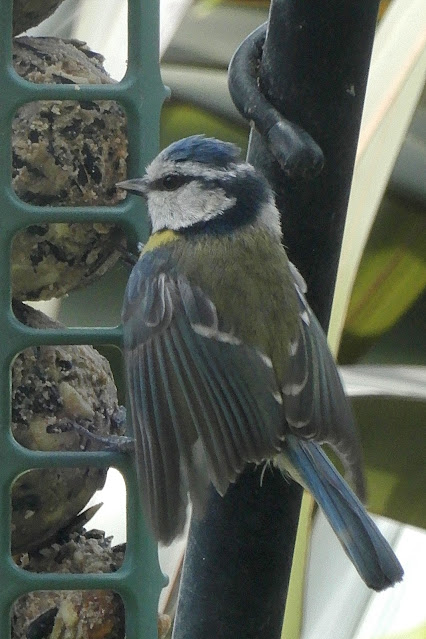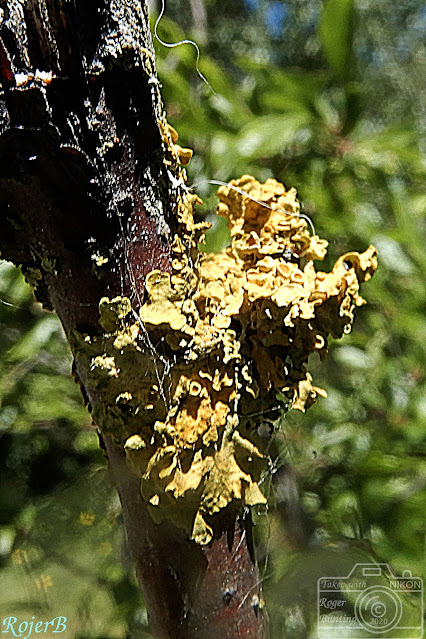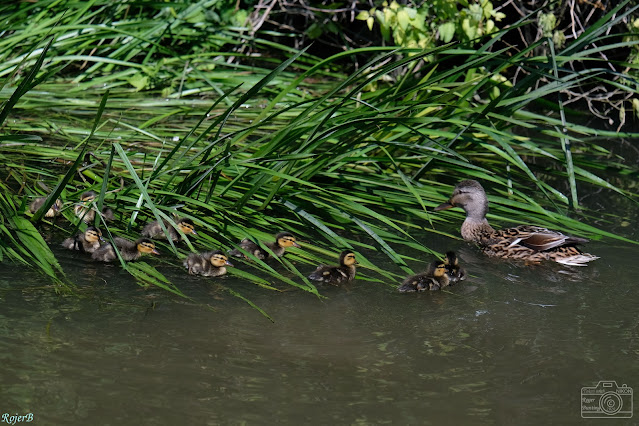May the Twenty Third
Sparrow feeding offspring
Sparrows are by far the commonest visitors to my garden feeders. I have seen up to two dozen at a time swinging about in the bush at the gate and on the fatball containers. When I chuck seed onto the footpath the sparrow telegraph works exceptionally well and within a couple of minutes there are ten or twelve squabbling about.
May the Twenty Fourth
Starlings in a row
The second by number are starlings, a traditionally and actually quarrelsome and noisy breed who thankfully don't stay for long.
Think that this was an old bird on its last legs
Bluetit on feeder
Bluetits are commoner now than they used to be, I suspect that this is because they have nests that tie them to the area. I have three distinct ones from East, West and South carrying scraps of fatball back to their young.
May the Twenty Fifth
Honeysuckle at my back gate
Prickly oxtongue masquerading as dandelion
Lichen on dead hawthorn branch
(I like lichen)
Haws after the blossom
Grebe still on the nest
The great crested grebe is a delightfully elegant waterbird with ornate head plumes which led to its being hunted for its feathers, almost leading to its extermination from the UK. They dive to feed and also to escape, preferring this to flying. On land they are clumsy because their feet are placed so far back on their bodies. They have an elaborate courtship display in which they rise out of the water and shake their heads. Very young grebes often ride on their parents' backs.
(RSPB)
Great crested grebes are directly responsible for my interest in photography. A few (10?, 12?) years ago I was near the western end of the pond when I saw a pair doing the graceful courting 'dance' and exchanging weed at the far side of the water. I had a little camera with me ('twas before phone cameras) and snapped away. When I looked at the pictures on my computer later I was so disappointed at the quality that within a week I had taken the train to Sheffield and spent several hundred pounds on a new DSLR* and lens.
*DSLR = Digital Single Lens Reflex
There are lots of ducklings both on the pond and on the canal.
Food for heron, crow and pike to name but three. A hatching of a dozen will often end up with only one or two surviving.
Isolating
 |
Fish in the canal |
What fish I know not - apart from pike and carp I cherish my ignorance.
Here's a few more ducklings on the canal
Two of the aforementioned pike - this day some naughty person had drained a pound somewhere 'upstream' of Worksop and consequently there was no water entering the pound. Why this led to the amazing clarity I'm not sure but the water was like glass. These two were about fifty yards apart baskng in the sun.
The pike is a large fish that can grow over a metre in length. It is found in lakes and slow-flowing rivers and canals that have a lot of vegetation. It uses these plants as hiding places when hunting, bursting out with remarkable speed to catch fish, frogs, small mammals or ducklings. Young pike are called 'jack' and will eat small fish and invertebrates. Pike spawn between March and May, returning to the same place every year. A large female can produce up to 500,000 eggs.
A pike can eat a prey item up to half its own body weight, even taking moorhens or young ducks. Because of its size and predatory nature there are many stories about very large pike. The largest specimen caught in the UK so far was found in 1992 in a lake in Wales: it weighed in at just over 21kg
There are lots of these common blue damsel flies on the canal - here's a couple creating the next generation.
The new 'nest' on the canal. Mum and dad have tried without success to persuade the kids to return to the pond.
Still on the nest
Wild rose




















No comments:
Post a Comment
Speak: